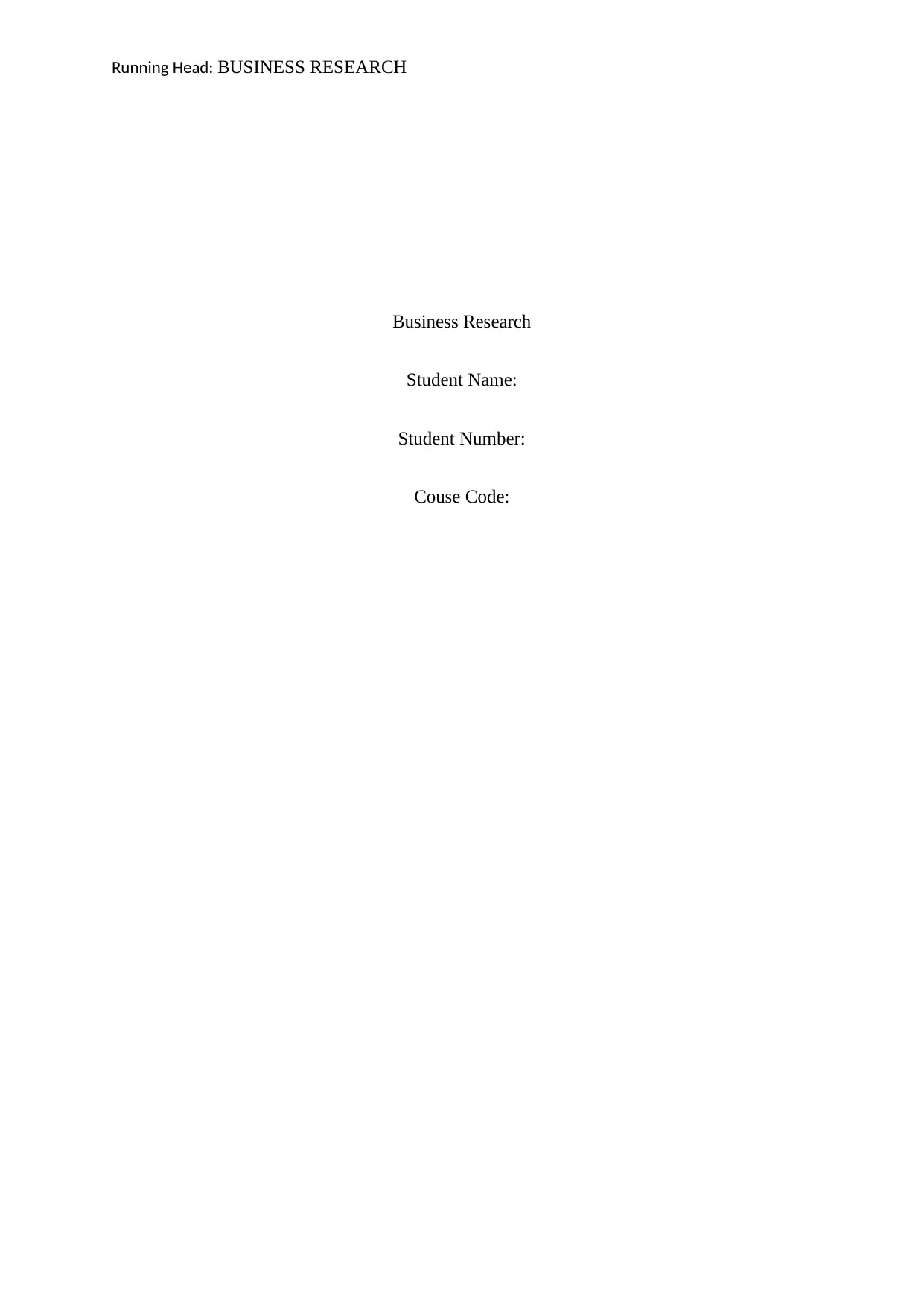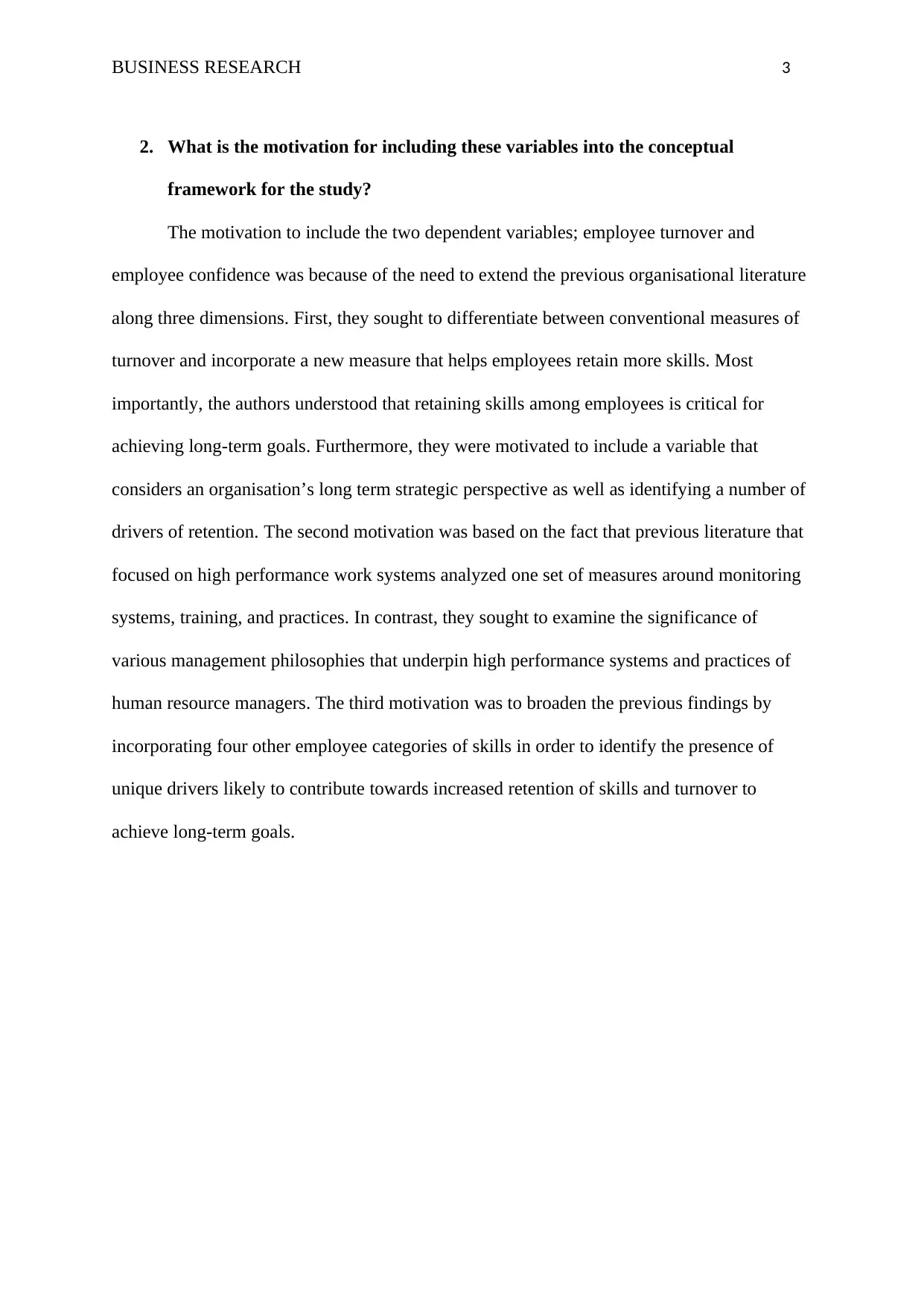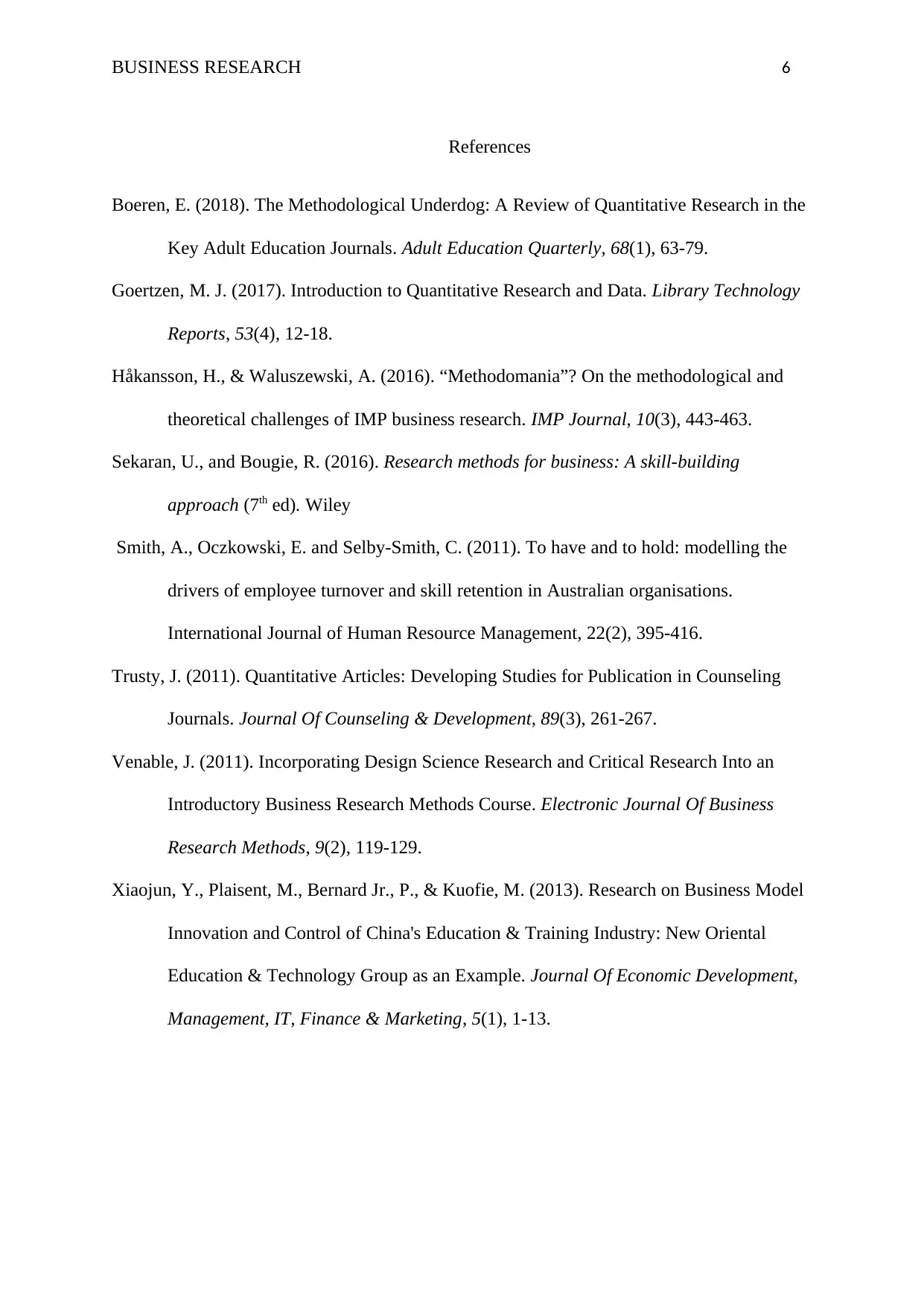Business Research: Modelling Employee Turnover and Skill Retention
VerifiedAdded on 2023/06/12
|6
|1335
|331
Report
AI Summary
This business research report analyzes the drivers of employee turnover and skill retention within Australian organizations, based on a study by Smith, Oczkowski, and Selby-Smith (2011). The report identifies employee turnover and employee confidence as key dependent variables, with learning orientation (LO), total quality management (TQM), and lean production (LP) as independent variables. The motivation for including these variables stems from the need to extend previous organizational literature, examine management philosophies underpinning high-performance systems, and broaden findings by incorporating various employee skill categories. The study measures employee turnover across four skill categories using nominal scales and multi-item scales for independent variables. The report suggests incorporating HR practices as a moderating variable to mediate the relationship between workplace learning, TQM, and turnover. Desklib provides access to this report along with a wealth of study resources, including past papers and solved assignments.

Running Head: BUSINESS RESEARCH
Business Research
Student Name:
Student Number:
Couse Code:
Business Research
Student Name:
Student Number:
Couse Code:
Paraphrase This Document
Need a fresh take? Get an instant paraphrase of this document with our AI Paraphraser

BUSINESS RESEARCH 2
1. What are the dependent, independent, moderating, mediating (intervening) or
control variables in this study? How are these variables defined?
Smith, Oczkowski and Selby-Smith (2011) use their journal to examine factors that
determine retention of long-term skills as well as turnover among employees working in
more than 300 Australian organisations. The authors collected primary data on two different
dependent variables. The two variables were employee turnover and employee confidence.
Smith, et al defined employee turnover as the percentage annual average over a period of
three years. More specifically, they measured the variable along four skill categories –
elementary skills, intermediate skills, skilled trade workers, and professional skills. While the
confidence to retail skills was defined by the degree at which an organisation was likely to
continue accessing the skills to assist achieve long term goals. While on the other hand, the
study focused on three independent variables including learning orientation (LO), total
quality management (TQM), and lean production (LP). Smith, defined LO as organisation-
wide activities that managers use to create and knowledge to strengthen competitive
advantage. They measured the variable along three-sub-constructs (shared vision, open-
mindedness, and commitment to learning). They defined TQM as a philosophy that managers
use when they want to achieve continuous improvement across all products and services as
well as processes (Xiaojun, et al., 2013). While LP was defined as a combination of TQM
and teamwork that managers used to operate through minimum resources.
1. What are the dependent, independent, moderating, mediating (intervening) or
control variables in this study? How are these variables defined?
Smith, Oczkowski and Selby-Smith (2011) use their journal to examine factors that
determine retention of long-term skills as well as turnover among employees working in
more than 300 Australian organisations. The authors collected primary data on two different
dependent variables. The two variables were employee turnover and employee confidence.
Smith, et al defined employee turnover as the percentage annual average over a period of
three years. More specifically, they measured the variable along four skill categories –
elementary skills, intermediate skills, skilled trade workers, and professional skills. While the
confidence to retail skills was defined by the degree at which an organisation was likely to
continue accessing the skills to assist achieve long term goals. While on the other hand, the
study focused on three independent variables including learning orientation (LO), total
quality management (TQM), and lean production (LP). Smith, defined LO as organisation-
wide activities that managers use to create and knowledge to strengthen competitive
advantage. They measured the variable along three-sub-constructs (shared vision, open-
mindedness, and commitment to learning). They defined TQM as a philosophy that managers
use when they want to achieve continuous improvement across all products and services as
well as processes (Xiaojun, et al., 2013). While LP was defined as a combination of TQM
and teamwork that managers used to operate through minimum resources.

BUSINESS RESEARCH 3
2. What is the motivation for including these variables into the conceptual
framework for the study?
The motivation to include the two dependent variables; employee turnover and
employee confidence was because of the need to extend the previous organisational literature
along three dimensions. First, they sought to differentiate between conventional measures of
turnover and incorporate a new measure that helps employees retain more skills. Most
importantly, the authors understood that retaining skills among employees is critical for
achieving long-term goals. Furthermore, they were motivated to include a variable that
considers an organisation’s long term strategic perspective as well as identifying a number of
drivers of retention. The second motivation was based on the fact that previous literature that
focused on high performance work systems analyzed one set of measures around monitoring
systems, training, and practices. In contrast, they sought to examine the significance of
various management philosophies that underpin high performance systems and practices of
human resource managers. The third motivation was to broaden the previous findings by
incorporating four other employee categories of skills in order to identify the presence of
unique drivers likely to contribute towards increased retention of skills and turnover to
achieve long-term goals.
2. What is the motivation for including these variables into the conceptual
framework for the study?
The motivation to include the two dependent variables; employee turnover and
employee confidence was because of the need to extend the previous organisational literature
along three dimensions. First, they sought to differentiate between conventional measures of
turnover and incorporate a new measure that helps employees retain more skills. Most
importantly, the authors understood that retaining skills among employees is critical for
achieving long-term goals. Furthermore, they were motivated to include a variable that
considers an organisation’s long term strategic perspective as well as identifying a number of
drivers of retention. The second motivation was based on the fact that previous literature that
focused on high performance work systems analyzed one set of measures around monitoring
systems, training, and practices. In contrast, they sought to examine the significance of
various management philosophies that underpin high performance systems and practices of
human resource managers. The third motivation was to broaden the previous findings by
incorporating four other employee categories of skills in order to identify the presence of
unique drivers likely to contribute towards increased retention of skills and turnover to
achieve long-term goals.
⊘ This is a preview!⊘
Do you want full access?
Subscribe today to unlock all pages.

Trusted by 1+ million students worldwide

BUSINESS RESEARCH 4
3. How are these variables measured?
Goertzen (2017) explains that any researcher much present a clear definition as well
as steps used to measure variables. Variable includes anything that is likely to take a different
value. Such values can be unique in terms of objects, person, or similar (Boeren, 2018;
Sekaran and Bougie, 2016). For instance, in order to measure employee turnover, the study
measured employee turnover on four categories. The professional category of skills were
measured based on nominal scale concerning the level of a manager such as in the senior
position, middle position, engineering technician, or as an ICT profession. The skilled trade
workers category was measured depending on the profession of an employee. Some of the
areas of measurement included skills such as plumber, electrician, messenger, or carpenter.
The intermediate skills were measured based on nominal scales as whether an employee
worked as a service worker, in sales department, or clerical department. While on the other
hand, the elementary skills involved focusing on machine operators, labourers.
In overall, the authors measured employee turnover with the help of four measures;
human resource management practices, organisational/market characteristics, training
practices, and high performance systems. Besides, Smith, et al measured the independent
variables based on management philosophies mostly related to high-performance work
systems. For example, they used multi-item scale items to measure learning orientation.
While on the other hand, they measured TQM and LP by looking at the extent of autonomy
that employee had in working with teams such as teamwork autonomy and teamwork
employed.
3. How are these variables measured?
Goertzen (2017) explains that any researcher much present a clear definition as well
as steps used to measure variables. Variable includes anything that is likely to take a different
value. Such values can be unique in terms of objects, person, or similar (Boeren, 2018;
Sekaran and Bougie, 2016). For instance, in order to measure employee turnover, the study
measured employee turnover on four categories. The professional category of skills were
measured based on nominal scale concerning the level of a manager such as in the senior
position, middle position, engineering technician, or as an ICT profession. The skilled trade
workers category was measured depending on the profession of an employee. Some of the
areas of measurement included skills such as plumber, electrician, messenger, or carpenter.
The intermediate skills were measured based on nominal scales as whether an employee
worked as a service worker, in sales department, or clerical department. While on the other
hand, the elementary skills involved focusing on machine operators, labourers.
In overall, the authors measured employee turnover with the help of four measures;
human resource management practices, organisational/market characteristics, training
practices, and high performance systems. Besides, Smith, et al measured the independent
variables based on management philosophies mostly related to high-performance work
systems. For example, they used multi-item scale items to measure learning orientation.
While on the other hand, they measured TQM and LP by looking at the extent of autonomy
that employee had in working with teams such as teamwork autonomy and teamwork
employed.
Paraphrase This Document
Need a fresh take? Get an instant paraphrase of this document with our AI Paraphraser

BUSINESS RESEARCH 5
4. Are there other important variables that should be included in this study?
Depending on the nature of a study, Trusty (2011) explains that researchers can opt to
include all four types of variables (dependent, independent, moderating, and mediating) to
help ascertain the cause and effect relationship among variables. However, Venable (2011)
points out that the choice to include either a moderating or mediating variables dependents on
the need to strengthen the relationship or effect of independent variable towards the
dependent variable. That implies incorporating a third variable to serve the role of moderation
or modify the original relationship.
The analysis of journal article of Smith, et al., (2011) indicates failure to incorporate a
third variable to help moderate two dependent variables (turnover and skill retention) and
three dependent variables (LO, LP and TQM). The study could include the role of HR
practises a moderating variable. The inclusion would help mediate (Håkansson and
Waluszewski, 2016) the relationship between learning at the workplace and TQM that predict
turnover.
4. Are there other important variables that should be included in this study?
Depending on the nature of a study, Trusty (2011) explains that researchers can opt to
include all four types of variables (dependent, independent, moderating, and mediating) to
help ascertain the cause and effect relationship among variables. However, Venable (2011)
points out that the choice to include either a moderating or mediating variables dependents on
the need to strengthen the relationship or effect of independent variable towards the
dependent variable. That implies incorporating a third variable to serve the role of moderation
or modify the original relationship.
The analysis of journal article of Smith, et al., (2011) indicates failure to incorporate a
third variable to help moderate two dependent variables (turnover and skill retention) and
three dependent variables (LO, LP and TQM). The study could include the role of HR
practises a moderating variable. The inclusion would help mediate (Håkansson and
Waluszewski, 2016) the relationship between learning at the workplace and TQM that predict
turnover.

BUSINESS RESEARCH 6
References
Boeren, E. (2018). The Methodological Underdog: A Review of Quantitative Research in the
Key Adult Education Journals. Adult Education Quarterly, 68(1), 63-79.
Goertzen, M. J. (2017). Introduction to Quantitative Research and Data. Library Technology
Reports, 53(4), 12-18.
Håkansson, H., & Waluszewski, A. (2016). “Methodomania”? On the methodological and
theoretical challenges of IMP business research. IMP Journal, 10(3), 443-463.
Sekaran, U., and Bougie, R. (2016). Research methods for business: A skill-building
approach (7th ed). Wiley
Smith, A., Oczkowski, E. and Selby-Smith, C. (2011). To have and to hold: modelling the
drivers of employee turnover and skill retention in Australian organisations.
International Journal of Human Resource Management, 22(2), 395-416.
Trusty, J. (2011). Quantitative Articles: Developing Studies for Publication in Counseling
Journals. Journal Of Counseling & Development, 89(3), 261-267.
Venable, J. (2011). Incorporating Design Science Research and Critical Research Into an
Introductory Business Research Methods Course. Electronic Journal Of Business
Research Methods, 9(2), 119-129.
Xiaojun, Y., Plaisent, M., Bernard Jr., P., & Kuofie, M. (2013). Research on Business Model
Innovation and Control of China's Education & Training Industry: New Oriental
Education & Technology Group as an Example. Journal Of Economic Development,
Management, IT, Finance & Marketing, 5(1), 1-13.
References
Boeren, E. (2018). The Methodological Underdog: A Review of Quantitative Research in the
Key Adult Education Journals. Adult Education Quarterly, 68(1), 63-79.
Goertzen, M. J. (2017). Introduction to Quantitative Research and Data. Library Technology
Reports, 53(4), 12-18.
Håkansson, H., & Waluszewski, A. (2016). “Methodomania”? On the methodological and
theoretical challenges of IMP business research. IMP Journal, 10(3), 443-463.
Sekaran, U., and Bougie, R. (2016). Research methods for business: A skill-building
approach (7th ed). Wiley
Smith, A., Oczkowski, E. and Selby-Smith, C. (2011). To have and to hold: modelling the
drivers of employee turnover and skill retention in Australian organisations.
International Journal of Human Resource Management, 22(2), 395-416.
Trusty, J. (2011). Quantitative Articles: Developing Studies for Publication in Counseling
Journals. Journal Of Counseling & Development, 89(3), 261-267.
Venable, J. (2011). Incorporating Design Science Research and Critical Research Into an
Introductory Business Research Methods Course. Electronic Journal Of Business
Research Methods, 9(2), 119-129.
Xiaojun, Y., Plaisent, M., Bernard Jr., P., & Kuofie, M. (2013). Research on Business Model
Innovation and Control of China's Education & Training Industry: New Oriental
Education & Technology Group as an Example. Journal Of Economic Development,
Management, IT, Finance & Marketing, 5(1), 1-13.
⊘ This is a preview!⊘
Do you want full access?
Subscribe today to unlock all pages.

Trusted by 1+ million students worldwide
1 out of 6
Related Documents
Your All-in-One AI-Powered Toolkit for Academic Success.
+13062052269
info@desklib.com
Available 24*7 on WhatsApp / Email
![[object Object]](/_next/static/media/star-bottom.7253800d.svg)
Unlock your academic potential
Copyright © 2020–2025 A2Z Services. All Rights Reserved. Developed and managed by ZUCOL.





